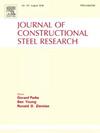Ductile fracture assessment of wire and arc additive manufactured steel materials
IF 4
2区 工程技术
Q1 CONSTRUCTION & BUILDING TECHNOLOGY
引用次数: 0
Abstract
This research aims to experimentally investigate the ductile fracture characteristics and the level of anisotropy of four plates, 400 mm × 150 mm × 3.72 mm, made by Wire Arc Additive Manufacturing (WAAM) technology with 1 mm thick layers. Relatively small roughness is measured, expressed in maximum peak-to-valley height, measured by scanning, of 98 μm. Calibrated parameters for an advanced computational material model are derived for a finite element mesh size of 0.5 mm. The experimental campaign is based on eight types of short coupon specimens, analysed to explore fracture behaviour exposed to various stress conditions. Sixty-five coupon specimens, 51 milled and 14 tested in as printed conditions, cut out in three directions relative to the printing direction, are examined. The assumption of isotropic mechanical characteristics is confirmed. The mesoscale critical equivalent plastic strain (MCEPS) methodology is used to predict experimental results numerically. Three stages are considered: elastic, plastic, and couple plastic-damaged stages. The accuracy of the calibrated parameters is validated by comparing the engineering stress-strain relationships obtained from experimental tests and finite element (FE) analysis, reaching very good agreement. A list of all material parameters for ductile fracture modelling at various triaxiality levels and Lode parameters is provided for a mesh size of 0.5 mm.
求助全文
约1分钟内获得全文
求助全文
来源期刊

Journal of Constructional Steel Research
工程技术-工程:土木
CiteScore
7.90
自引率
19.50%
发文量
550
审稿时长
46 days
期刊介绍:
The Journal of Constructional Steel Research provides an international forum for the presentation and discussion of the latest developments in structural steel research and their applications. It is aimed not only at researchers but also at those likely to be most affected by research results, i.e. designers and fabricators. Original papers of a high standard dealing with all aspects of steel research including theoretical and experimental research on elements, assemblages, connection and material properties are considered for publication.
 求助内容:
求助内容: 应助结果提醒方式:
应助结果提醒方式:


